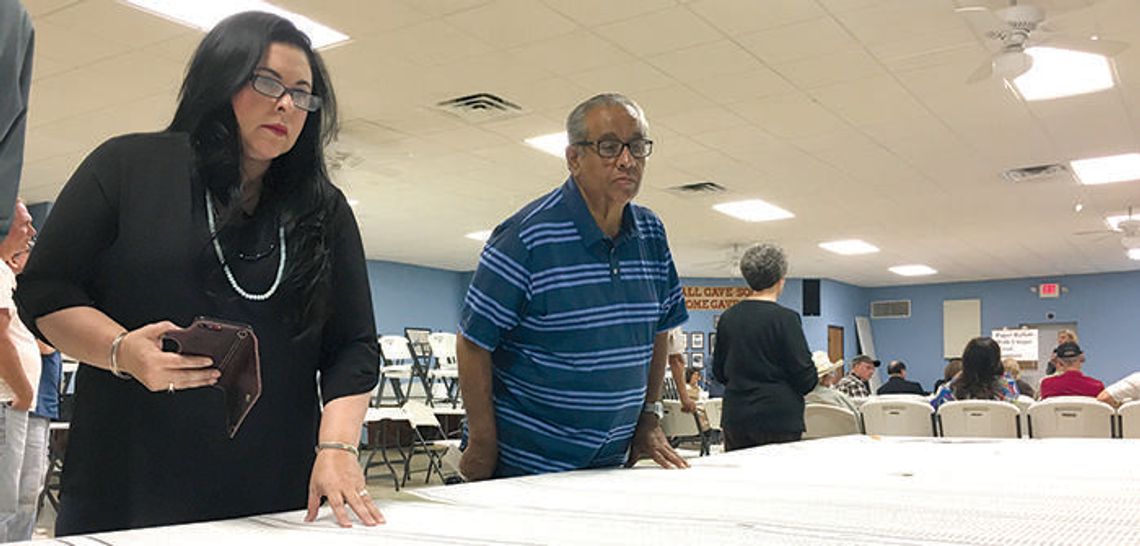Ever since he cast his first ballot as an 18-year-old in 1968, San Marcos resident Sam Montoya has made it a habit to participate in the democratic process whenever it came up.
But on Monday, Montoya was “shocked” to discover the ballot he cast in Nov. 8, 2016 general election was one of 1,800 votes not counted due to a policy lapse at an early voting location.
Now Montoya hopes something can be done to prevent a similar issue from happening again. For some Hays County residents, implementing a paper balloting system is the solution, despite county officials saying the snafu was a policy lapse, and not an equipment error.
“I hope they take care of this. I’m really disappointed my vote didn’t count,” Montoya said. “I know there are people who are angry. I’m not angry, but I’m disappointed.”
Many residents who advocate for paper balloting attended a citizens forum at the Maurice T. Suttles VFW Post in San Marcos Monday.
“It’s interesting when we’re expected to be open when we have so many more advisory committees that spend more money than we are, and they aren’t expected to be open.” Jennifer Anderson, Hays County elections administrator
Representatives from Election Systems & Software (ES&S), which is one of two vendors Hays County is considering to replace outdated voting systems, attended the forum and demonstrated their “hybrid” paper and electronic voting system.
The Hays Free Press reported in April that county officials had planned to replace outdated voting equipment prior to Nov. 8, 2016 issue. Jennifer Anderson, Hays County elections administrator, said ES&S and Hart Intercivic are the only two vendors that can comply with Texas’ strict laws on voting equipment.
The policy issue occurred under Anderson’s predecessor’s reign.
Prior to the demonstration, however, residents shared fears that the county’s current electronic systems are not reliable and do not allow for accountability.
Hays County resident Ashley Whittenburger said having a paper ballot system “just makes sense,” as it would allow for a way for officials to “clearly audit an election.”
She was concerned the county is treating the issue with “such casualness” and felt officials were trying to sweep the problem under the rug.
“That’s just common sense. If we have no paper ballot or serial numbers attached to a ballot, how can we tell there’s a problem with an election?” Whittenburger said.
Arthur Taylor, a San Marcos resident, discovered his vote, along with his son’s and wife’s, were among the 1,800 not counted. He liked the idea of a paper ballot system, similar to the hybrid system presented by ES&S.
That system would be made up of printing ballots on thermal paper, then inserting those into a computer. Representatives from ES&S claim the hybrid system would allow for three levels of transparency, where voters see their choices on screen and on the ballot, as well as have a digital image of the ballot.
Taylor was concerned about the accountability with the county’s current electronic systems and with transparency, primarily with the county’s selection of new equipment.
“Some accountability has to be there. I believe some criminal action should be taken because this is inexcusable,” Taylor said. “There’s no way they’re going to tell me 1,800 votes would not have made a difference in this election.”
Anderson said the county has taken steps to rectify the issues, which affected the outcome of the Anthem Municipal Utility District vote. Following an investigation, Anderson implemented policy changes to how the county handles its mobile ballot boxes (MBB), which was mistakenly taken offline at an early voting location at the Hays County Government Center in San Marcos.
Hays County Judge Bert Cobb reached out to Rolando Pablo, the Texas Secretary of State (SOS), regarding the Nov. 8, 2016 issue. In a letter, Keith Ingram, Texas director of elections, said while the SOS office doesn’t have any investigative authority, the report done by Anderson “correctly identified” the problem and took appropriate steps to rectify it. The SOS didn’t believe a further review was necessary.
Anderson said there were no voting issues in the May 6 general election.
She said the county is also attempting to be as transparent is it can be with the new equipment. An 11-person committee was commissioned to assist the county with its new election system.
However, she said those committee meetings are not open to the public, as it’s not required by law. A committee member can make to motion to vote on whether it can be open.
“It’s interesting when we’re expected to be open when we have so many more advisory committees that spend more money than we are, and they aren’t expected to be open,” Anderson said.
Whichever vendor the county chooses could also impact whether or not the county can have “voting centers” in future elections. Voting centers, which were used in Travis and Williamson Counties, are locations where voters of any precinct can cast a ballot on Election Day. Under the current Hays County system, voters on Election Day can only vote in their assigned precinct location.
Only direct recording equipment (DREs) or electronic voting systems are allowed at a voting center, per state law. Hybrid systems are not DREs, Anderson said.
“I don’t think anyone is trying to exclude the public from the meeting,” Anderson said. “But it’s obvious that people are trying to distract. We’re trying to make sure we focus on the objective and focus on the equipment.”










